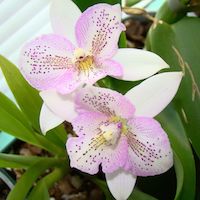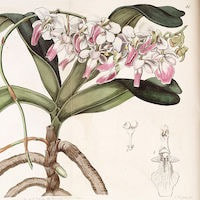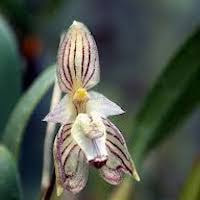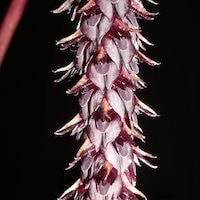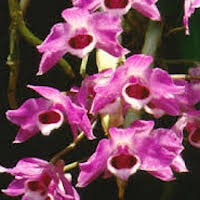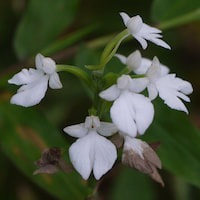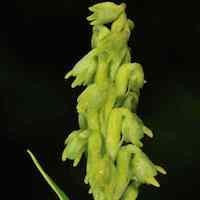Experience the Essence of Well-Being with Citrus Aromatherapy for Women
This essential oil contains scented notes os several orchids, such as :
Diacattleya-Pink: This orchid is both fragrant and visually stunning, with its flowers changing color from pink to beige as they mature. Orchid enthusiasts appreciate its beautiful perfume, making it a perfect gift for someone special.
Aerides crispa: Known as "children of the air," this epiphytic orchid has large, robust leaves with purple spots. Its drooping inflorescence bears many flowers. Ear-drops made from the plant are used to alleviate earaches, possibly due to the presence of aeridin, a bactericidal compound.
Bulbophyllum ambrosia: With fragrant white flowers adorned with crimson stripes, this orchid is harvested for its medicinal properties. It is used in Chinese traditional medicine to treat hepatitis, coughs, and lung heat.
Bulbophyllum cylindraceum: This orchid species features dense, dark purple flowers resembling catkins. It blooms during different months in China, Bhutan, and Nepal. The entire plant is used to relieve painful joints and numbness.
Diacattleya-Pink: This orchid is both fragrant and visually stunning, with its flowers changing color from pink to beige as they mature. Orchid enthusiasts appreciate its beautiful perfume, making it a perfect gift for someone special.
Aerides crispa: Known as "children of the air," this epiphytic orchid has large, robust leaves with purple spots. Its drooping inflorescence bears many flowers. Ear-drops made from the plant are used to alleviate earaches, possibly due to the presence of aeridin, a bactericidal compound.
Bulbophyllum ambrosia: With fragrant white flowers adorned with crimson stripes, this orchid is harvested for its medicinal properties. It is used in Chinese traditional medicine to treat hepatitis, coughs, and lung heat.
Bulbophyllum cylindraceum: This orchid species features dense, dark purple flowers resembling catkins. It blooms during different months in China, Bhutan, and Nepal. The entire plant is used to relieve painful joints and numbness.
Download the guided mediation that works best with this Orchid fragrance oil
| women_citrus_essential_oil_orchi_00009.mp3 | |
| File Size: | 114032 kb |
| File Type: | mp3 |
Enhance Your Wellness Routine with Our Healthy Fragrance Oil
Contains Scented Notes of following in various proportions:
Native Singaporean Orchid notes: Diacattleya-Pink
|
Diacattleya-Pink - Used in Citrus 9 (Women) for Team building Perfume workshop
While many orchid lovers believe that most Cattleya orchids are fragrant, experienced growers may have a different opinion. While many Cattleya varieties do possess a fantastic scent, some of the visually stunning ones may disappoint in terms of fragrance. However, the Diacattleya-Pink stands out with its beautiful perfume and the added allure of its flowers changing color from pink to beige as they mature. This orchid is not only fragrant but also visually captivating, making it an ideal gift for someone special. |
Therapeutic Orchid notes:
|
Aerides crispa Lindl.
The name "children of the air" for Aerides crispa comes from the Greek words aer (air) and eides (resembling), which reflects its epiphytic nature and how these orchids are cultivated. A. crispa is a large, tough, and robust epiphyte with young leaves adorned with purple spots. Its inflorescence can reach up to 35 cm in length, drooping, branching, and loosely bearing many flowers. In the Western Ghats, ear-drops made by boiling the pulverized A. crispa plant in neem oil are used to treat earaches. These ear-drops are instilled into the ear, typically 2-3 drops per night. A. crispa contains aeridin, a bactericidal phenanthropyran compound. Although the exact contribution of aeridin to the management of earaches is uncertain, it exhibits bactericidal properties. |
|
Bulbophyllum ambrosia
Chinese name: Fangxuianshidou Lan (fragrant stone bean orchid), Xiangshidou Lan (fragrant stone bean orchid) Chinese medicinal name: Fangzhucao Bulbophyllum ambrosia produces fragrant flowers that are borne individually, measuring 2 cm across. These flowers are white with crimson longitudinal stripes and bloom from February to May. The herb is sourced from Fujian, Guangdong, Guangxi, and Yunnan and can be harvested throughout the year. It is utilized in its fresh, steamed, or dried form. In Chinese Traditional Medicine (CTM), a decoction is made by boiling the dried herb, which is then used to treat conditions such as hepatitis, coughs, and lung heat. The taste of the herb is described as dry, bland, and cold in nature. |
|
Bulbophyllum cylindraceum
Chinese Name: Dabaoshidou Lan (large bud stone bean orchid) Dense dark purple flower look like catkin. In China, it flowers from October to January, in October to January in Bhutan and November in Nepal. It is obtained from Sichuan and Yunnan. Entire plant is used to treat painful joints and numbness. |
|
Dendrobium. Parishii Rchb. f.
Local Name: Xishishihu (named after the classic southern beauty Xishi), Other Common Names: Zibanshihu (Purple feet Dendrobium) Thai Names: Ueang Kraang Sai Sun, Ueang Sai Nam Kraang, Ueang Nam Khrang, Ueang attakrit, Ueang lathakrit, Ueang khrang. Myanmar Name: Khayang yaung twin pyin This unique Dendrobium orchid showcases a captivating rose-purple color and emits a delightful fragrance reminiscent of rhubarb. It is primarily found in a limited range spanning from Indochina to northern Thailand, Yunnan, Myanmar, Bangladesh, and Arunachal Pradesh. This orchid is known for its abundant blooms and has a remarkable ability to enhance the yin element, reduce fever, alleviate thirst, and promote the secretion of body fluids. |
|
Habenaria plantaginea Lindl.
Bangladeshi name: Kusuma gadda This Habenaria species is widely distributed, being found in the under-storey of dry zone forests in Sri Lanka, as well as throughout India below 900 m and in Bhutan between 1000 and 2500 m. It is also present in Bangladesh, Myanmar, and the Lesser Sunda Islands. The tubers of this plant have various herbal uses, including the treatment of wasting diseases, fever, blood disorders, hemorrhage, and fainting. In the Eastern Ghats of Andra Pradesh, the tubers are pounded with black pepper and garlic to create tablets that are used to alleviate chest pain and stomach ache. Similar remedies are also employed in Bangladesh for the same purposes. |
|
Herminium monorchis (L.) R. Br.
Chinese names: Jiaopan Lan (angle plate orchid), Ren shen guo Chinese medicinal name: Rentouqi This particular orchid species has a flowering period that spans from June to September. It follows a reproductive cycle where two ovoid tubers are formed each season. The larger tuber develops leaves and flowers in the subsequent season, while the smaller tuber detaches to initiate a new plant. This orchid primarily reproduces vegetatively. It has a wide distribution across temperate Eurasia, ranging from Japan, Korea, northern China, and Russia to all of Europe. It can also be found in central Asia and the Himalayas. This terrestrial orchid thrives in moist locations, typically in damp grassland or short turf, on non-calcareous soils. In terms of herbal usage, the entire plant is utilized to enrich yin and provide benefits to the kidney and stomach. It is prescribed for various conditions such as nervous breakdown, confusion, insomnia, thirst, anorexia, precocious greying of hair, and to strengthen and nourish a weak body. In a small, non-controlled, open trial involving 93 patients with chronic constipation, oral treatment with glucomannan at a dosage of 1 g three times a day resulted in improvement without any reported side effects. |
Other scent note
Grapefruit, Lime, Jabuticaba, fruit tropical, neroli, Litsea cubeba, fig, gooseberry and lemon verbana
Scentopia Library Reference ingredient
Yuzu - Check details at Scentopia's scent library
Join Scentopia's wonderful orchid scent crafting, fragrance tour, bridal shower or corporate team building which includes perfume making onsite and offsite, beach activities and more. We also serve primary school learning journey, secondary students and pupil on industrial excursions. Know more about our orchids perfume bar or therapeutic orchid scents and other wellness aromas. Conatct Perfume workshop or book a scent crafting session here.
